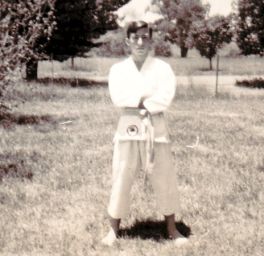
______________________________________________________________–
1968 and the start of my karate walk back in Vryheid Natal with the JKA club that was 5 hours away from Durban. 1967 I had a blue belt student that worked in a post office in Danielskuil teach me the basics.
1982 the New Beginning and the a New dawn and chapter in my life. Hout Bay dojo that grew to over 70 members and produced top quality students and many sport karate champions
2000 and the transition to Seiwakai under Ben Mare Kyoshi 8th Dan – See more under instructor






___________________________________________________________
A direct original student of the Late Leo Lipinski Hanshi when he was in Durban. He Trained with Seiwakai Tasaki and after many years with Goju Kai SA, Ben returned to Seiwakai and shortly after that I followed and joined Seiwa Kai in 2000.
Ben and Myself spent many years with the IKGA- Gojukai South Africa under Peter Brandon Hanshi who was our immediate sensei. Our training was tough and of the highest level and through that training, it made us what we are today . www.seiwakai.org.za
__________________________________________________________________
Born January 21st, 1909 Died May 20 1989


Japanese Nippon Goju kai (Japan Goju Association) teaches an orthodox Goju ryu style. There are certain differences to the Okinawan Goju ryu way of karate.
There are differences of emphasis rather than anything else the same kata are used but there are occasional minor variations in stances, for example.
More over Goju kai is a somewhat “lighter'” style, too, and does no make extensive use of the chashi, chishi and other supplementary conditioning equipment.
Also, like other Japanese karate styles Goju kai makes more use of kicks, and has placed more emphasis on free style sparring as a training method.
As we noted earlier, the free sparring is a bit closer than in some other Japanese styles. Instructors like to see students use Goju techniques, such as the distinctive open hand blocks, and keep the techniques flowing.
Another feature is the high use of groin kicks, the kick is made with the instep and in sparring it is directed to the inside thigh.
__________________________________________________________–
Shuji Tasaki, Hanshi (1933 – 2011) founder of Seiwakai Goju Ryu. Began his training in Goju Ryu in 1952 under the tutelage of Gogen Yamaguchi. 1971 he formed Seiwakai.

Tasaki always respectfully acknowledged Gogen Yamaguchi as his first and only teacher and it it evident that they had a special bond.
Seiwakai karate Do became one of the most successful Goju Ryu karate associations in Japan and internationally. Tasaki was awarded 9th Dan in the Japan Karate Federation (JKF) Goju Kai in 2009, and passed away on 30th January 2011.
Tasaki Hanshi maintained good relationships with Gogen Yamaguchi sensei and his family. Favorite training was Kumite that Tasaki excelled in, along with other great fighters like Takahashi and Yamamoto.
Tasaki hard fighting method of Kumite was passed down to Leo Lipinski Hanshi and to Ben Mare 8th Dan Kyoshi. Without doubt our dojo in Tableview Cape Town and Durban hold to his teaching, and standard, as passed down.
Subsequently the instructors continue in his path and keep his legacy alive.



Legacy of Shuji Tasaki Hanshi Continues
Syllabus for grading from beginner to 5th Dan is centered on the traditional Japanese style of Goju Ryu Karate Do, passed down from Gogen Yamaguchi sensei to Tasaki Sensei / Goshi Yamaguchi Hanshi. See Peter Klipfel Kyoshi
Karate practiced worldwide and recognized by the International Olympic Committee and The World Karate Federation. There are 5 blocks in the karate world : Goju Ryu – Shotokan – Shito Ryu – Wado Ryu and Kyokushin.